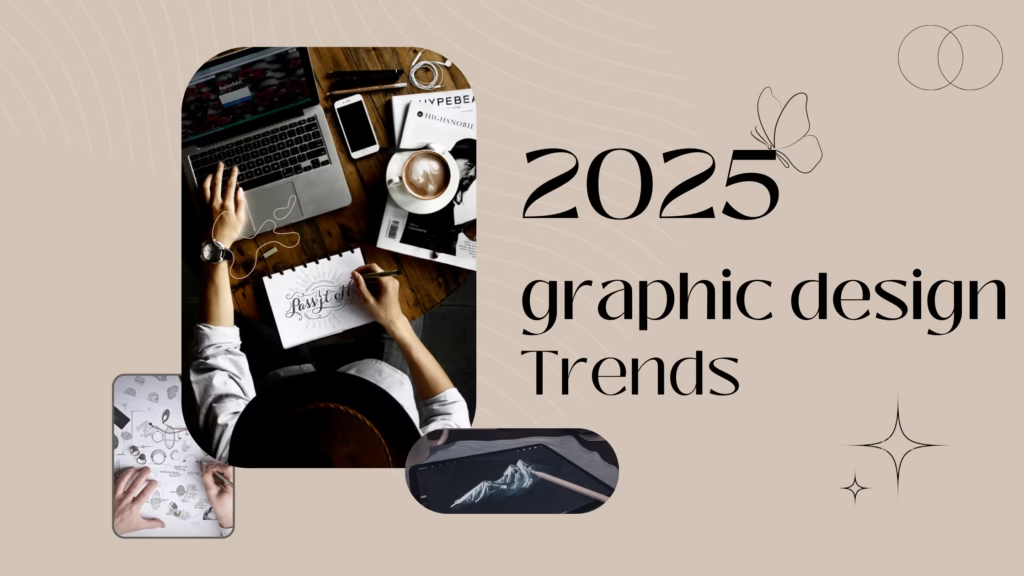
The world of graphic design continues to evolve, offering new ways to captivate audiences and elevate brands. As we move into 2025, Graphic Design Trends 2025 showcases a design landscape rich with innovation, blending cutting-edge technology with nostalgic elements. This guide will unpack the top trends shaping the industry, how to use them effectively, and pitfalls to avoid. Let’s dive into the creative wave of 2025!
1. Hyperrealistic Design
Hyperrealism takes realism to the next level, creating designs that blur the line between the digital and the real. Leveraging tools like Adobe Firefly and advanced 3D software, hyperrealistic designs are perfect for:
- Product shots: Showcase items with photorealistic details.
- Architectural visualizations: Create lifelike renderings of spaces.
- Virtual worlds: Immerse users in dynamic, interactive environments.
Tips:
- Focus on lighting and texture for authenticity.
- Combine with augmented reality (AR) to enhance user interaction.
2. Custom Typography
Bespoke fonts are gaining traction as brands strive to stand out. Custom typography creates a unique visual identity and elevates storytelling.
Applications:
- Branding and logos.
- Digital campaigns.
- Editorial designs.
Avoid pitfalls:
- Ensure readability across platforms.
- Balance uniqueness with brand tone.
3. Anaglyph Effects
The nostalgic red-and-blue 3D aesthetic is back, offering playful and engaging visuals. It is one of the best graphic design trends 2025
Best used for:
- Social media content.
- Event posters.
- Digital art projects.
Tip: Pair anaglyph effects with minimalist layouts to maintain clarity.
4. Character-Based Branding
Cartoon characters and mascots are becoming essential for humanizing brands. These add relatability and personality, making brands memorable.
Examples:
- Corporate mascots.
- Illustrated characters for product packaging.
Tip: Align character traits with your brand’s core values for authenticity.
5. Aurora Effects
Inspired by the northern lights, aurora effects use soft, gradient-like transitions to evoke serenity and wonder.
Applications:
- Backgrounds for websites and apps.
- Advertisements and posters.
- Video overlays.
Best practice: Stick to a subtle gradient palette to avoid overwhelming viewers.
6. Bento Box Layouts
This Japanese-inspired trend organizes content into modular grids, offering clarity and structure.
Ideal for:
- Websites.
- Digital dashboards.
- Portfolio presentations.
Advantages:
- Improved user navigation.
- Enhanced aesthetic balance.
7. Neomorphism
A blend of skeuomorphism and flat design, neomorphism uses soft shadows and subtle 3D effects.
Use cases:
- UI/UX design for apps.
- Button designs.
- Interactive dashboards.
Avoid pitfalls:
- Ensure sufficient contrast for accessibility.
8. Dark Mode
Dark mode remains a staple, offering sleek aesthetics and improved readability in low-light conditions.
Best for:
- Mobile apps.
- Websites.
- Presentations.
Pro Tip: Use neon or contrasting colors to make elements pop against dark backgrounds.
9. AI-Generated Design
Artificial intelligence is revolutionizing design, streamlining workflows and generating creative concepts.
Applications:
- Rapid prototyping.
- Creative brainstorming.
- Automating repetitive tasks.
Examples of tools: MidJourney, Adobe Firefly, and Canva AI.
10. Accessible Design
Inclusivity in design ensures usability for all, including people with disabilities.
Key principles:
- High-contrast color schemes.
- Scalable typography.
- Intuitive navigation.
Tip: Test designs with accessibility tools like WAVE or Lighthouse.
11. Nostalgia and Vintage Minimalism
The ’70s are back! Faded color palettes, retro stripes, and checkered patterns are perfect for invoking nostalgia while keeping designs clean and modern.
Applications:
- Branding.
- Packaging.
- Social media posts.
Tip: Blend vintage elements with modern layouts to stay relevant.
12. Anti-Design
This rebellious trend embraces imperfection with mismatched fonts, overlapping text, and unconventional layouts.
Ideal for:
- Edgy branding.
- Experimental projects.
- Art installations.
Warning: Use sparingly to avoid overwhelming users.
13. Motion Graphics & Animation Trends
Dynamic content is more engaging than ever. Leading trends include:
- 3D animation: Hyperrealistic and immersive.
- 2D animation: Stylized and expressive visuals.
- Stop motion: Quirky, frame-by-frame storytelling.
Applications:
- Marketing campaigns.
- Explainer videos.
- Social media reels.
14. Augmented Reality in UI/UX
AR is reshaping user interaction by blending physical and digital spaces.
Examples:
- Virtual tours.
- Product demos.
- AR-enhanced apps.
Tip: Combine AR with minimalist UI for seamless user experiences.
Final Thoughts
The graphic design trends of 2025 blend technological advancements with timeless aesthetics. From hyper-realistic visuals to nostalgic vintage styles, there’s a trend for every creative goal. By staying adaptable and leveraging these trends thoughtfully, designers can create captivating and inclusive experiences for their audiences.
What trends are you excited to try? Let us know in the comments below!
also, check our other posts
